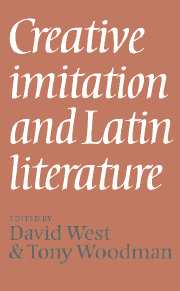Book contents
- Frontmatter
- Contents
- CONTRIBUTORS
- Prologue
- 1 DE IMITATIONE
- 2 PLAVTVS VORTIT BARB ARE: Plautus, Bacchides 526–61 and Menander, Dis exapaton 102–12
- 3 FROM POLYPHEMUS TO CORYDON: Virgil, Eclogue 2 and the Idylls of Theocritus
- 4 TWO PLAGUES: Virgil, Georgics 3.478–566 and Lucretius 6.1090–1286
- 5 HORATIAN IMITATIO AND ODES 2.5
- 6 IVDICIVM TRANSFERENDI: Virgil, Aeneid 2.469–505 and its antecedents
- 7 SELF-IMITATION WITHIN A GENERIC FRAMEWORK: Ovid, Amores 2.9 and 3.11 and the renuntiatio amoris
- 8 SELF-IMITATION AND THE SUBSTANCE OF HISTORY: Tacitus, Annals 1.61–5 and Histories 2.70, 5.14–15
- 9 LENTE CVRRITE, NOCTIS EQVI: Chaucer, Troilus and Criseyde 3.1422–70, Donne, The Sun Rising and Ovid, Amores 1.13
- 10 PYRAMUS AND THISBE IN SHAKESPEARE AND OVID: A Midsummer Night's Dream and Metamorphoses 4.1–166
- 11 EPILOGUE
- Notes
- Abbreviations and bibliography
- Select indexes
10 - PYRAMUS AND THISBE IN SHAKESPEARE AND OVID: A Midsummer Night's Dream and Metamorphoses 4.1–166
Published online by Cambridge University Press: 12 March 2010
- Frontmatter
- Contents
- CONTRIBUTORS
- Prologue
- 1 DE IMITATIONE
- 2 PLAVTVS VORTIT BARB ARE: Plautus, Bacchides 526–61 and Menander, Dis exapaton 102–12
- 3 FROM POLYPHEMUS TO CORYDON: Virgil, Eclogue 2 and the Idylls of Theocritus
- 4 TWO PLAGUES: Virgil, Georgics 3.478–566 and Lucretius 6.1090–1286
- 5 HORATIAN IMITATIO AND ODES 2.5
- 6 IVDICIVM TRANSFERENDI: Virgil, Aeneid 2.469–505 and its antecedents
- 7 SELF-IMITATION WITHIN A GENERIC FRAMEWORK: Ovid, Amores 2.9 and 3.11 and the renuntiatio amoris
- 8 SELF-IMITATION AND THE SUBSTANCE OF HISTORY: Tacitus, Annals 1.61–5 and Histories 2.70, 5.14–15
- 9 LENTE CVRRITE, NOCTIS EQVI: Chaucer, Troilus and Criseyde 3.1422–70, Donne, The Sun Rising and Ovid, Amores 1.13
- 10 PYRAMUS AND THISBE IN SHAKESPEARE AND OVID: A Midsummer Night's Dream and Metamorphoses 4.1–166
- 11 EPILOGUE
- Notes
- Abbreviations and bibliography
- Select indexes
Summary
THE OVIDIAN FRAMEWORK
The tale of Pyramus and Thisbe in Book 4 of the Metamorphoses comes within a group of stories set in Boeotia. The previous book begins with Cadmus and ends with Pentheus (the Theban king who was so horribly punished for resisting Dionysus). Book 4 itself begins with the daughters of Minyas, king of Orchomenus. These girls also offended Dionysus; for instead of joining in his worship they stayed at home telling stories. And they too were punished: as dusk fell, the scent of saffron and myrrh filled the air, wild music was heard, vines sprouted from their looms, and they were suddenly turned into bats.
Within this Boeotian setting we have three love-stories told by the daughters of Minyas. The first is that of Pyramus and Thisbe, the second (in three related parts) is about the Sun, and the third concerns the Carian water-nymph Salmacis. The girl who told of Pyramus and Thisbe1 had other stories which she could have recounted. She thought first of the Babylonian goddess Derceto (44–6) who was changed into a fish; then of Derceto's daughter (Semiramis) who became a bird; and then of an unnamed nymph who turned boys into fishes and eventually became a fish herself. But she settled finally on the story of how the white mulberry became red. Of these tales three, and possibly all four, are Babylonian. The oriental setting is mentioned explicitly in v. 56: Pyramus was the most handsome young man and Thisbe the loveliest of the girls quas Oriens habuit. So at the very beginning we learn that Ovid has in mind an eastern story of youth and beauty.
- Type
- Chapter
- Information
- Creative Imitation and Latin Literature , pp. 173 - 194Publisher: Cambridge University PressPrint publication year: 1979



